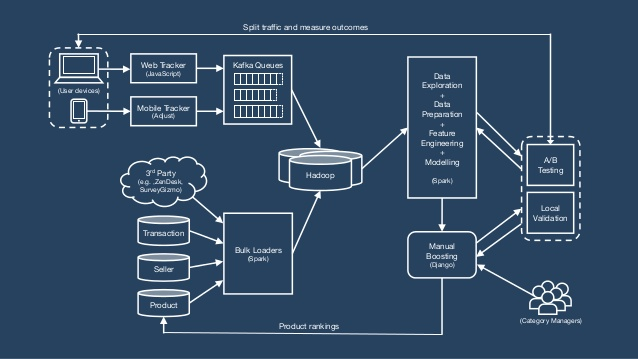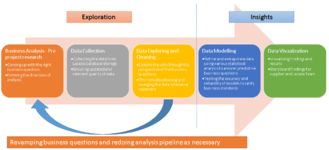Difference between revisions of "ANLY482 AY2016-17 T1 Group4: Project Overview"
| Line 49: | Line 49: | ||
== Project Details == | == Project Details == | ||
===System Architecture === | ===System Architecture === | ||
| − | [[Image: | + | [[Image: LazadaSA.png | center]] |
<br> | <br> | ||
Revision as of 18:54, 31 December 2016
Motivation & Business Problem
Lazada is still small compared to major competitors (e.g. Aliexpress / Amazon / Tao Bao) and it still needs to continue expanding and strengthening its user base before it can start to focus on realizing its profit goals. Despite its small size, it has significant market penetrations across many different countries in South-East Asia. That said, as a relative newcomer in the industry, it needs to prepare to for the serious market competition that Amazon might bring in the future. One way to provide a barrier to entry towards Amazon is to understand its buyers and sellers better and offer more effective strategies to enhance their experiences.
Current Issues
Lazada currently has millions of products listed where many versions of the same product are being sold. Buyers may find their online experience hindered by many conflicting factors in making a decision, such as lower prices, shorter time to delivery, and higher transaction reputation. To help buyers gain quick access to the best products in the catalogue/search results, intelligent ranking orders of all available product items needs to be generated to help buyers make preferred decisions and sellers get better sales.
Difficulty measuring features which lead to higher conversion rates and better customer experience
One of the key drivers of a customer’s experience throughout the purchase journey (from online browsing to receiving a product) is the product’s quality. However, product quality is hard to determine due to no fixed way of measuring it. A methodology is required to assess what attributes contribute most to customers’ impression of product quality. On top of that, there are other useful features that have yet to be explored, including seller rating.
Project Objectives
As such, the objective of our team is to model possible predictors for conversion rate and customer experience through measures of product quality and seller rating features.This will be used to derive recommendations in Lazada's on-site ranking system to enhance customer experience through quick access to the best products in customer’s catalogue.
Project Details
System Architecture
Product & Seller Features (Predictive Variables)
Product Quality (online)
- What factors have an effect on conversion and customer experience?
- How should we adjust our website to improve online engagement, and NPS?
Product Quality (delivery)
- What factors have an effect on conversion and customer experience?
- What can we do to improve customer NPS after they have received their product?
Seller Rating
- What factors have an effect on conversion and customer experience?
- Which factors should we prioritize when building a seller dashboard?
Conversion Rate & Customer Experience Metrics
Conversion Rate
Conversion Rate is the percentage of visits which results in e-commerce transactions (sales). It helps to calculate how many visitors (shoppers) are actually turning into buyers (customers). High or higher conversion rate is the ultimate target for the business.
Customer Experience
Customer Experience is the entire interactions that a customer has with the brand, organization, or e-commerce platform in this case, and an organization should aim to deliver most enjoyable and usable experience to existing and potential customers.
Formulas:
Entire Website: E-commerce Conversion Rate = (Total E-commerce transactions / total visits on a website) * 100
By Product: E-commerce Conversion Rate for a product = (Product Transaction / Product page visits) * 100
For this project, we can get Conversion Rate from data collected, or get calculated Conversion Rate from Google Analytics platform since Lazada Group holds GA account.
Another important aspect of Conversion Rate is the factors that have high correlation with high Conversion Rate (eg) Shorter payment process, coupon. This will be examined by correlation and/or regression analysis from softwares like SPSS.
Formulas:
Net Promoter Score (NPS): % of Promoters - % of Detractors
Promoters (score 9-10): loyal customers who keep buying and referring to others
Detractors (score 0-6): dissatisfied customers who might spread negative comments and word-of-mouth
Data Source
Nature of Dataset
To be obtained on approval (11th January).
Methodology
Data Collection
This will be done to form the pipeline of data extraction from Lazada database and Google Analytics. The challenge is to properly pull out quality data from the relevant and updated sources.
Data Exploration and Cleaning
Manage exploratory analysis of these data. These analysis will be used to improve on business questions which also affect the exploratory analysis. This process will be done repeatedly with necessary data cleaning and munging until we find business questions which accurately express business needs given the data and exploratory analysis made. Data Modelling
After a proper exploratory phase of the analysis, we will train and test machine learning models to to answer predictive and prescriptive business questions. This will include processes such as clustering to segment user behaviours, regression to include impacts of various seller attributes to CX Metrics, etc. Various statistical learning models such as Random Forest and Regularization might also be used to reduce risk of overfitting and increase testing accuracy of models.
Data Visualization
These data analysis will be documented visually Jupyter Notebook or interactive dashboard tools which are later demonstrated and presented to business users such as Lazada suppliers and internal teams. Insights presentation techniques such as Storyboarding and Pyramid technique (Barbara Pinto) might also be used to ensure proper presentation to match findings and business needs.

